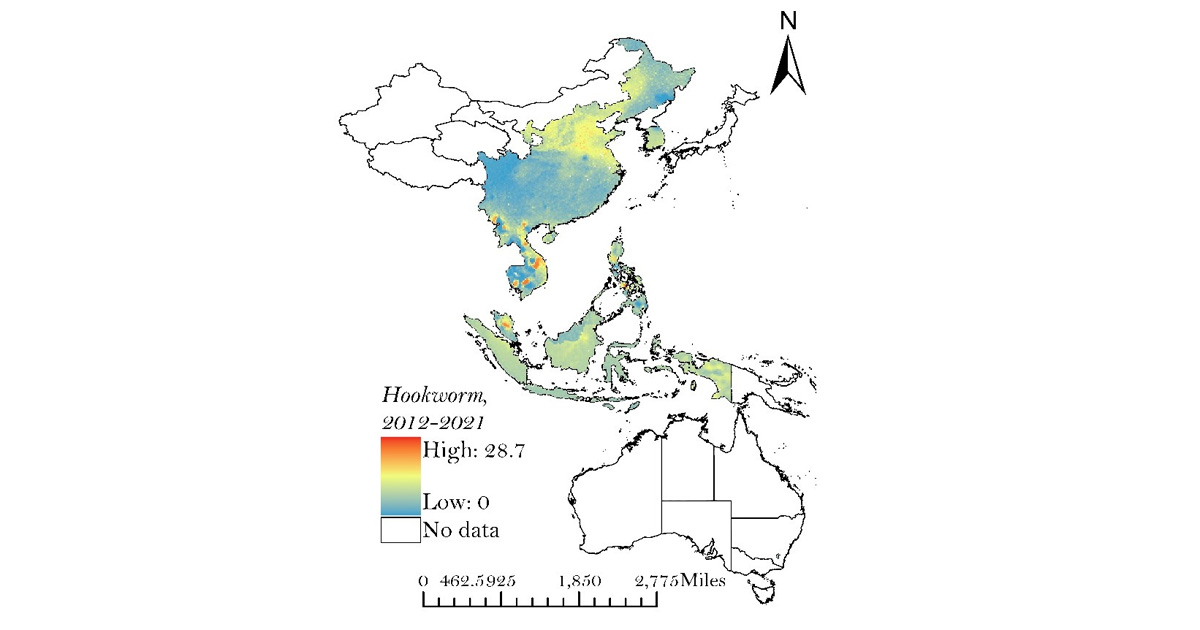
Map depicting Western Pacific hotspots for parasitic worms.
A global research team led by geospatial modelling experts from The Kids Research Institute Australia and Curtin University has provided the first detailed maps identifying hotspots across the Western Pacific Region where debilitating parasitic worms are rife.
Soil-transmitted helminth (STH) infections – which include hookworm, roundworm and whipworm – are among 20 conditions determined by the World Health Organization to be neglected tropical diseases (NTDs).
They affect an estimated 1.5 billion people globally, with those living in disadvantaged populations – including more than 900 million children in low- and middle-income countries across sub-Saharan Africa, Southeast Asia and parts of Latin America – most at risk.
“Children are particularly vulnerable due to their frequent exposure to contaminated environments and their developing immune systems,” said co-lead author Beth Gilmour, from The Kids and Curtin.
“Infection can result in chronic and debilitating morbidity and can lead to malnutrition, anaemia, impaired physical and cognitive development, and poor school performance.”
STH infections are primarily spread through contact with soil contaminated by human faeces, often due to inadequate sanitation and hygiene infrastructure. Control strategies rely heavily on preventive chemotherapy – the routine administration of deworming medication to at-risk populations, particularly school-aged children, to reduce infection burden and prevent complications.
Co-lead author Haileab Wolde, also from The Kids and Curtin, said WHO had set a global target to eliminate NTDs by 2030, but efforts to meet that deadline had been derailed by persistent underlying risk factors including poverty, population growth and climate change.
“Understanding the distribution of infection prevalence is key to maximising control efforts, but in countries where NTDs prevail, information on prevalence is limited and difficult to obtain due to resource constraints,” he said.
To fill this gap, the team used an analytical approach known as spatial predictive mapping to provide prevalence estimates at a small scale of resolution – allowing them to identify ‘hotspots’, even where parasitological data is limited.
Prediction mapping has been successfully applied in the past to diseases including HIV, tuberculosis, malaria, cholera and dengue, and to STH infections in South America and South Africa. Data was still lacking for the Western Pacific Region, however, leaving major gaps in efforts to tackle the problem.
In a paper published this week in The Lancet Regional Health – Western Pacific, the team produce high-resolution spatial prediction maps which reveal notable geographical variations in STH prevalence.
Senior author Associate Professor Kefyalew Alene – Head of Geospatial and Tuberculosis research at The Kids and an infectious diseases epidemiologist with the Curtin School of Population Health – said the results suggested that while significant progress had been made in reducing the prevalence of some STH species in the region, persistent high-risk hotspots remained in China, Cambodia, Malaysia and Vietnam.
“In the areas covered by our study, which spans multiple countries in the Western Pacific Region, millions of children remain at risk, with prevalence rates in some settings exceeding 30–50 per cent among school-aged children,’’ Associate Professor Alene said.
“These findings show the urgent need for targeted deworming programs and improved sanitation, especially in communities where children bear a disproportionate burden of infection.”
In particular, the study identified a trend of increased prevalence of the parasitic roundworm, Strongyloides stercoralis, and found Indigenous and ethnic minorities carry a disproportionately high level of STH infection.
“Although ongoing survey data collection is required, this geospatial analysis will be a critical tool enabling the WHO, governments and other agencies to accelerate STH elimination efforts to achieve the 2030 targets,” Associate Professor Alene said.
This research was funded by the National Health and Medical Research Council and was a collaboration between The Kids Research Institute Australia, Curtin University, the Australian National University, the University of Queensland, the University of Canberra, the Kirby Institute, QIMR Berghofer Medical Research Institute, the Research Institute for Tropical Medicine in the Philippines, Queens University, Belfast, and the Institute of Public Health at the University of Gondar, Ethiopia.
